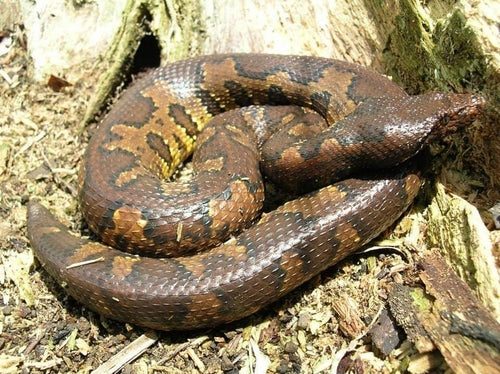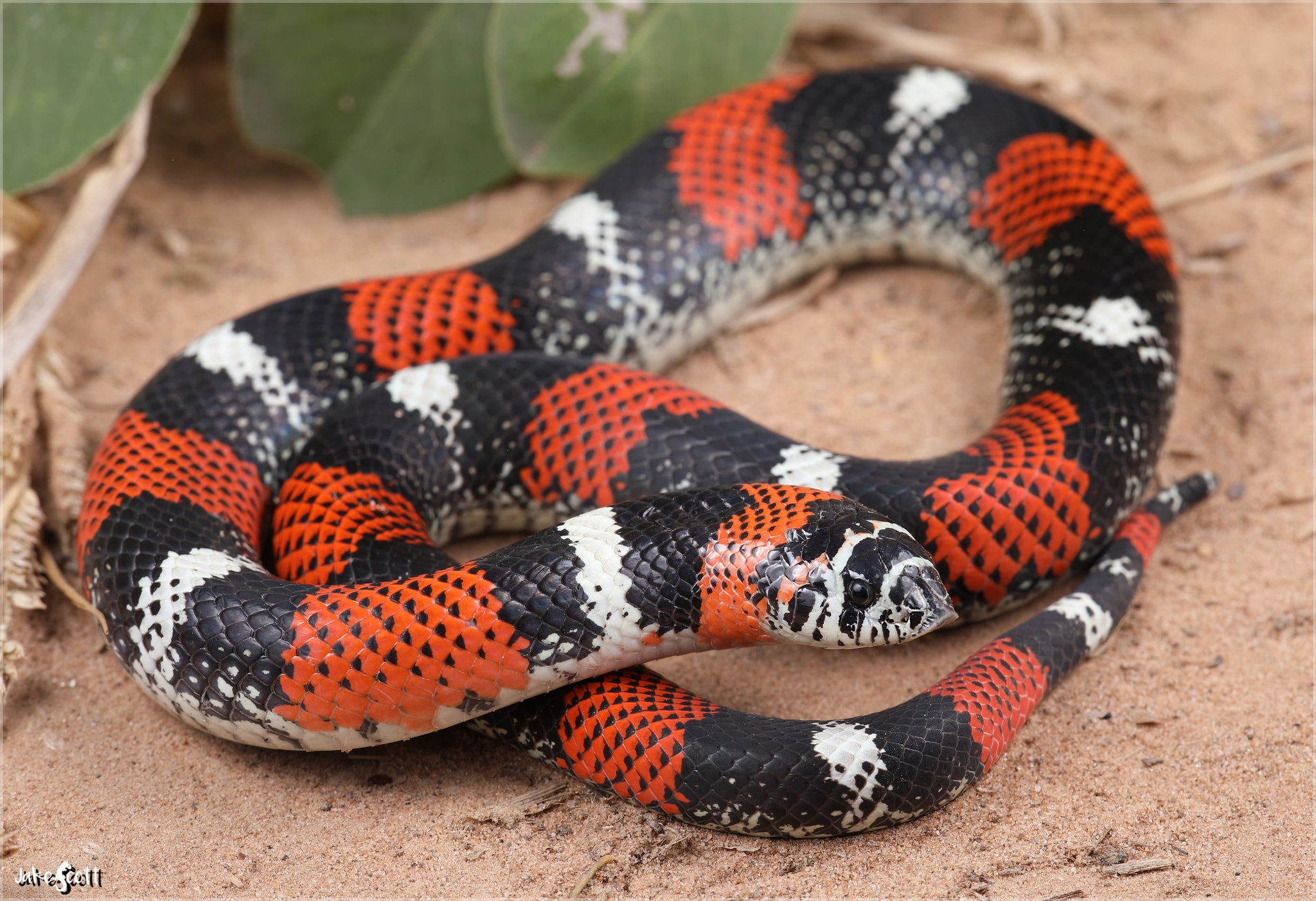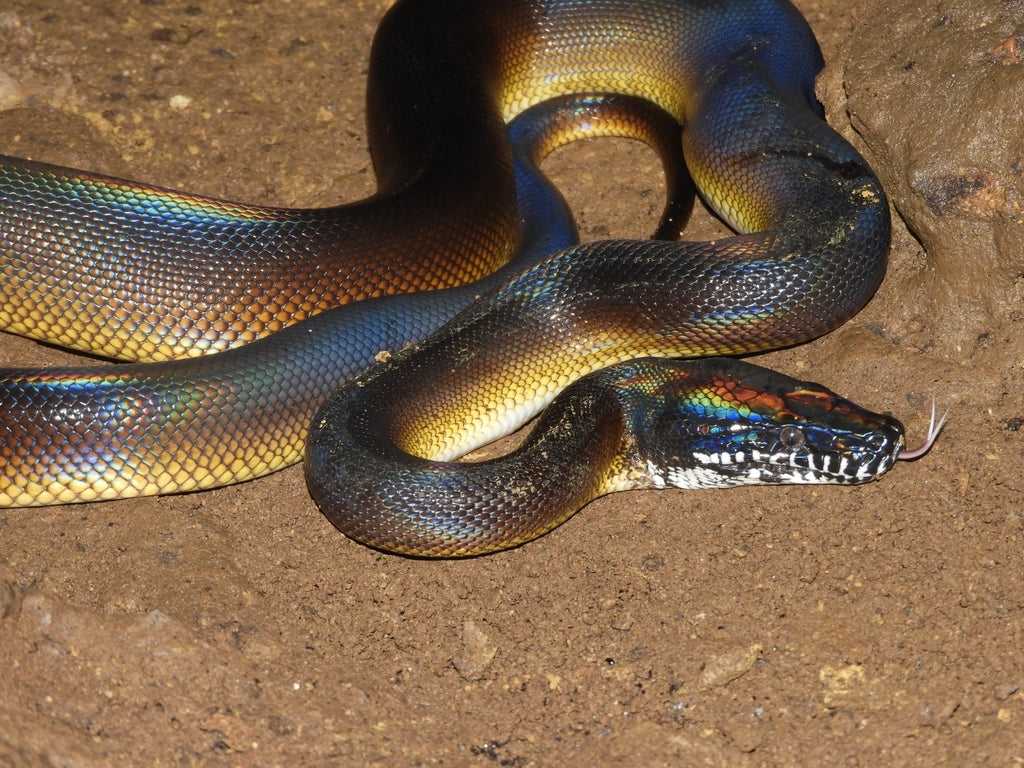Viper boas (Candoia aspera) are small, terrestrial, nocturnal snakes native to New Guinea and surrounding islands. They prefer a tropical forest habitat, where they like to hide in mud and leaf litter. This species is also known as the New Guinea ground boa.
True to their common name, viper boas have a viper-like appearance with a short, thick body; keeled scales, and a slender, pointed head. However, they are non venomous. These snakes are generally 15-28” long as adults, but some females can get as large as 36” long. Males are significantly smaller than females. Coloring is variable across individuals, and even individuals experience color changes related to temperature, mood, time of day, and age. Viper boas can be golden, orange, reddish, brown, or almost black, with a blotched/banded pattern.
Viper boas make low-maintenance, manageably-sized pets, although their preference for reptile and amphibian prey and their nocturnal, reclusive nature offers more of a challenge. With good care, captive-bred viper boas are capable of living at least 20 years.
How much space do viper boas need?
Although viper boas are fairly sedentary snakes, they still need an enclosure that allows them to stretch out fully, thermoregulate, and explore as desired. The minimum for appropriately keeping one viper boa is 36”L x 18”W x 16”H, but larger is likely to be beneficial and get fully utilized by the snake. For the snake’s comfort, this enclosure should be front-opening and have opaque sides.
Cohabitation (keeping multiple viper boas in one enclosure) is not recommended, as this is not a social species.
Do viper boas need UVB?
Viper boas are capable of surviving without access to UVB, but they can’t thrive without it, which means that access to UVB lighting is necessary to optimal health and wellbeing. UVB gives reptiles all of the vitamin D that their bodies need, stimulates better appetite and activity, and generally allows them to be healthier than they would be without.
Viper boas do best with low-strength UVB as part of their enclosure. Here are the best UVB bulbs for viper boas:
- Zoo Med Reptisun T5 HO 5.0, 22”
- Arcadia Forest 6%, 22”
The UVB bulb should be housed in a reflective fixture such as Arcadia or Vivarium Electronics, and placed close to the heat lamp, about 9-11” above the snake’s back if over mesh, and 12-14” above the snake’s back if not. Make sure that the fixture your UVB bulb is in does not have a clear plastic or glass bulb cover, as these materials block UVB. UVB lighting also decays over time, so make sure to replace your bulb every 12 months to maintain its performance.
Due to their equatorial origin, viper boas should receive roughly 12 hours of light year-round.
What basking temperatures do viper boas need?
Like other reptiles, viper boas are ectotherms, which means that they need a temperature gradient in their enclosure to help them regulate their metabolism and stay healthy.
Viper boas like to stay relatively cool. They should have a basking surface temperature between 86-90°F, down to 78-82°F on the cool side. It is very important that they have ready access to a cool area in the enclosure, or else they will get stressed. Temperatures should be measured with digital probe thermometers.
Provide heat for your viper boa by imitating the sun with a low-wattage halogen heat bulb placed on one side of the enclosure. This should create an area of gentle heat large enough to evenly heat the snake’s entire body when coiled. Do not use colored bulbs, as these are not as effective. If temps get too high, dim the bulbs with a plug-in lamp dimmer or proportional thermostat. If temps are too low, you need higher-wattage bulbs.
Light-based heating should be turned off at night. However, the ambient temperature should not get below 75°F at night, so if you need to boost nighttime temps, use a ceramic heat emitter or radiant heat panel connected to a thermostat.
What humidity levels do viper boas need?
Viper boas need an environment that is humid and moist. Strive to keep average ambient humidity levels between 50-80%, lower during the day and higher at night. Measure the humidity in your snake’s enclosure with a digital probe hygrometer placed in the middle of the enclosure. It’s also good practice to provide a humid hide for your snake, lined with moistened sphagnum moss. Providing an area of muddy substrate on one side of the enclosure will likely be appreciated.
Misting your snake’s enclosure with a sprayer first thing in the morning and again at night will help create the right humidity levels. If you need more, pouring water into the substrate or using a cool-mist humidifier connected to a hygrostat is also helpful.
Viper boas are known to enjoy spending time in water, so make sure to provide an extra-large water bowl on the cool side of the enclosure so they can soak their entire body as desired. Ideally, this water tub should be large enough for a bit of swimming, but it shouldn’t need to be more than 6” deep. Keep the water in this tub/bowl clean at all times and disinfect it weekly.
What substrate is good for viper boas?
Viper boas require a thick layer of moisture-retentive substrate to cushion their bodies and help maintain healthy humidity levels. As an added perk, it also tends to make the enclosure more attractive.
We recommend the following substrates for viper boas:
- Zoo Med Eco Earth
- Zoo Med ReptiSoil
- Exo Terra Plantation Soil
- Zilla Jungle Mix
- Galapagos Terrarium Sphagnum Moss
Adding a thick layer of clean, chemical-free leaf litter on top of the substrate can also help with humidity and provides additional cover to help your snake feel secure in its environment.
Substrate should be at least 3” deep and completely replaced every 3-4 months. Remove poop and urates daily, along with contaminated substrate.
What decor can you use in a viper boa terrarium?
It’s terribly boring and even stressful for a snake to be stuck in an enclosure with nothing in it. It doesn’t matter how big the enclosure is if you don’t put things in it for your pet to use and interact with.
Aside from substrate and a big water bowl, here are some other things to include in your viper boa’s setup:
- hides/caves
- thick, low branches
- cork tubes/flats
- artificial plants
- sturdy live plants
What do viper boas eat?
Like other snakes, viper boas are carnivores, which means that they need to eat whole animal prey in order to get the nutrition that they need. They have slow metabolisms and are prone to obesity, so it’s important not to feed them too much or too often. Here is a basic feeding schedule to get you started:
- Juveniles — every 10-14 days
- Adults — every 21-28 days
Prey items should be around 10% of your snake’s weight and/or no wider than the snake’s body at its widest point. Although live prey can be used, it’s safest and most humane to use frozen instead. Prey should be thawed in a plastic bag in warm water before offering with a pair of soft-tipped tweezers.
Remember, the key to great nutrition is variety! While viper boas can eat rodents, they are naturally amphibian/lizard eaters in the wild, so it’s best to use Reptilinks, feeder frogs, and feeder anoles as their primary source of prey, with only occasional rodents. This lower-calorie diet also helps prevent obesity.
Supplements
Viper boas can survive without vitamin or mineral supplements, but occasionally using them can help prevent nutritional deficiencies and optimize your snake’s health. We recommend Repashy Calcium Plus LoD.
Do viper boas like to be handled?
Few reptiles actually “like” to be held, and viper boas have something of a reputation as being “nasty,” bitey snakes. However, this reputation is more rumor than fact, as properly-kept, unstressed, captive-bred viper boas can be quite docile. That being said, there are still some basic rules for handling viper boas:
Wait at least 2 weeks before attempting to handle a new viper boa, and more if you have a juvenile. Babies and juveniles tend to be more nervous and defensive than adults. Be gentle, and pick up the snake from below rather than from above. Support as much of its body as possible, and NEVER pick a snake up by its tail! Keep handling sessions brief at first, and always end them on a positive note, with the snake acting calm.
If you’re worried about getting nipped, wear a pair of thick leather gloves.
*This care sheet contains only very basic information. Although it’s a good introduction, please do further research with high-quality sources to obtain additional information on caring for this species.
“Photo 118898272” by Amir Hamidy is licensed under CC BY-NC 4.0




Leave a comment
This site is protected by hCaptcha and the hCaptcha Privacy Policy and Terms of Service apply.